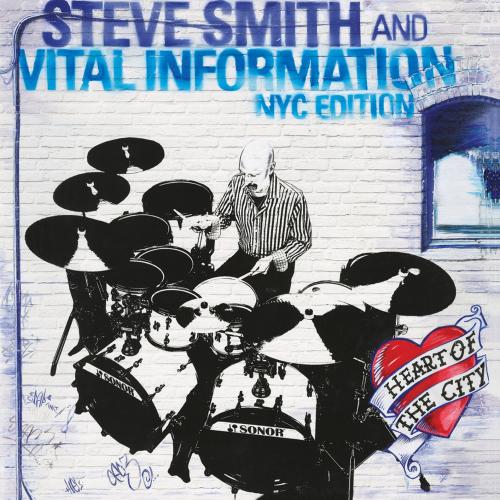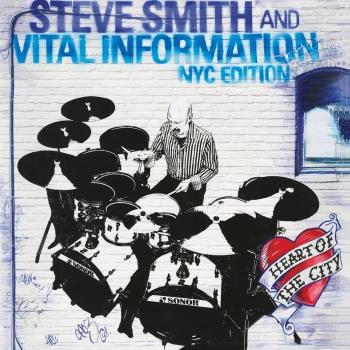
Heart of the City Steve Smith & Vital Information NYC Edition
Album Info
Album Veröffentlichung:
2017
HRA-Veröffentlichung:
03.07.2020
Label: BFM Jazz
Genre: Jazz
Subgenre: Contemporary Jazz
Interpret: Steve Smith & Vital Information NYC Edition
Das Album enthält Albumcover
- 1 Mr. Pc 06:20
- 2 Rhythm-a-Ning 05:22
- 3 Eight Five 05:52
- 4 Bugalulu 04:55
- 5 Heart of the City 05:33
- 6 City Outskirts East 02:42
- 7 I Love You 07:26
- 8 I'm an Old Cowhand (From the Rio Grande) 05:45
- 9 City Outskirts West 02:32
- 10 Open Dialogue 04:00
- 11 Charukeshi Express 03:46
- 12 Cherokee (Indian Love Song) 05:33
Info zu Heart of the City
Die Drummer Legende Steve Smith kehrt als Bandleader mit seiner All-Star-Gruppe Vital Information NYC Edition - Baron Browne (Bass / Vocals), Mark Soskin (Klavier), Vinny Valentino (Gitarre) zurück um eine brandneue Studioaufnahme zu veröffentlichen, Heart Of The City. Dieses erstaunliche Album kennzeichnet vertraute Standards sowie originale Kompositionen, die von Mitgliedern der Vital Information NYC Edition geschrieben wurden.
Warum eine Kombination von Originalen und Standards? Bei Vital Information NYC Edition ist jedes Mitglied der Gruppe ein hervorragender Jazz-Improvisator. Die Verbindung zwischen allen Jazz-Musikern ist die gemeinsame Ausbildung und Beweis für die Entwicklung eines Repertoires von Standards und Demonstration ihrer Fertigkeit auf vertrautem Material. Wenn ein Jazzmusiker nur seine eigenen Kompositionen spielt wird es schwierig oder gar unmöglich seine Fähigkeiten wirklich zu beurteilen, weil sie ihre Stärken und Grenzen nicht zulassen, sie spielen nur zu ihren Stärken. Kreativ sein mit vertrautem Material ist eine bewährte Methode, um einen zeitgenössischen Kommentar auszudrücken, mit personalisierten Ideen, basierend auf Kompositionen, die dem der Test der Zeit Stand gehalten haben. Dieses Album zeigt die Zeitlosigkeit der Jazz-Standards und ergänzt um inspiriertes Originalmaterial.
Steve Smith, drums, konnakol
Baron Browne, acoustic & electric basses, vocals on Eight + Five
Mark Soskin, acoustic piano & Fender Rhodes
Vinny Valentino, electric guitar
Andy Fusco, alto saxophone on Mr. P.C., Bugalulu and Heart Of The City
George Brooks, tenor saxophone, alto saxophone & drones on Charukeshi Express
Steve Elliot Smith
At the age of two, Steve Elliot Smith could already be found playing a drum set. His parents were the main culprits behind this hobby of his since the idea of getting him a kit was their’s. Unfortunately, Steve Smith’s drum set didn’t last long, seeing it was a toy-set and he didn’t know how to play. However, that experience planted the seeds for what Steve Smith was yet to become, one of the best drum-set players of all time.
It wasn’t until 1963 came along that Steve Smith began playing drums. It all came about at a school assembly where musical instruments were being demonstrated. At the end of the assembly, students were given the opportunity to play any instrument they liked. Seeing he was a big fan of hearing marching bands in parades, Steve Smith chose the instrument he loved to hear the most: the snare drum. Steve Smith was completely jaded and began taking drum lessons almost immediately.
Steve Smith’s first drum teacher was Bill Flanagan, a big-band drummer from the swing era that lived in the Boston, Massachusetts area. For the first two years Steve Smith played on a practice pad exclusively, while learning about drum rudiments and reading. On his third year of lessons Steve Smith began playing and practicing on a snare drum. He eventually got his hands and feet on a drum kit and began learning about independence and how to play the instrument in a jazz context.
“My practice sessions then didn’t take place on the drumset. I used to practice on a practice pad all the time—just practicing to records. Half of it would be trying to understand the different drum parts and copying them, and the other part would be improvising, using the record for tempo. I think that not practicing on a drumset then was a mistake. It would have been better if I had, because I would have developed faster as a drumset player.” Steve Smith in “Steve Smith” by Robyn Flans, Modern Drummer Magazine, August, 1986.
Steve Smith’s major inspiration at the time were great big-band drummers like Gene Krupa, Buddy Rich, Louie Bellson and Kenny Clarke. Regular trips to The Boston Globe Jazz Festival had a special impact on Steve Smith since it was where he first saw and heard his idols play. Steve Smith didn’t get interested in rock music until 1967 when he heard Jimi Hendrix with Mitch Mitchell on drums and Ginger Baker with Cream.
During his high-school years Steve Smith kept himself quite busy by going through the school-band program, playing with a professional concert band, the Bridgewater State University’s big band and every other kind of gig he could find: weddings, circus bands and local garage bands. After he was done with high school, Steve Smith went on to study music at the Berklee College Of Music, Boston from 1972 to 1976, where he was mentored by renowned teachers like Gary Chaffee and Alan Dawson. His influences at that point in time were mainly fusion drummers like Tony Williams, Billy Cobham, Lenny White and Steve Gadd.
Steve Smith’s professional drumming career began in 1974 as a 19-year old musician for the Lin Biviano Big Band. He toured and recorded with the band during 1974 and 1975’s summer breaks. During that period of time he also played for Buddy DeFranco and the free-jazz band The Fridge. In 1976 Steve Smith began playing fusion music when he joined violinist Jean Luc Ponty’s group, with whom he recorded the album Enigmatic Ocean (1977) with Allan Holdsworth on guitar.
In January, 1978 the 23-year-old Steve Smith left Jean-Luc Ponty and moved to Los Angeles, California to immerse himself in the music business and jump-start his career. In his first week there he auditioned successfully for jazz trumpeter Freddie Hubbard and rock guitarist Ronnie Montrose. Ronnie was getting ready to embark in a three-month solo tour of instrumental music from Open Fire (1978). Steve Smith was way more intrigued with Ronnie’s music than with Freddie’s since he was already quite fluent in jazz music. Therefore, he chose to go on tour with Ronnie Montrose instead of Freddie Hubbard. As it turned out, Ronnie Montrose’s tour was actually as a supporting act, alongside Van Halen, for Journey’s first tour as a headliner. The three bands had a lot of fun together and got to know each other pretty well.
Later on, Steve Smith found out Journey was thinking of getting a new drummer. They were looking for someone that could play fusion, as well as pop-rock with an R&B feel to it. Curiously, they found in Steve Smith the potential and qualities they were looking for, although he wasn’t doing much of that on the tour with Ronnie Montrose. A couple of months after the tour, Journey called Steve Smith and invited him to join the band as a full-time member.
“I wasn’t looking to be in a rock band but since the opportunity came my way I thought, ‘okay let’s check it out, this should be interesting.’ I agreed to join the band and I was excited to play with some very good rock players. Also I hadn’t done much work with singers, so working with a great singer sounded interesting too. I moved from Los Angeles to San Francisco and we got right to work.” Steve Smith in “Steve Smith – The Journey Days” on MikeDolbear.com.
Dieses Album enthält kein Booklet










